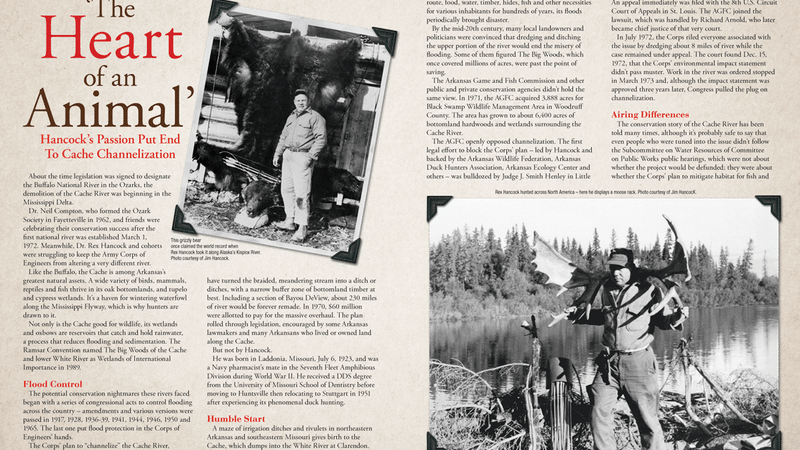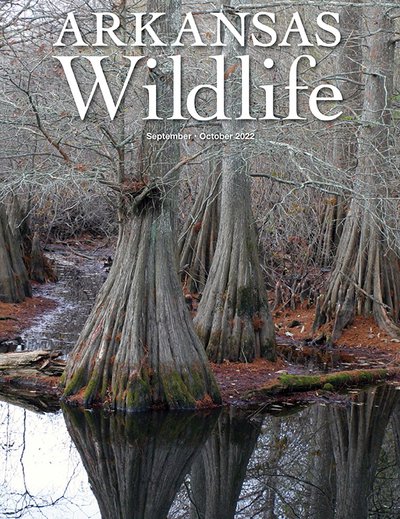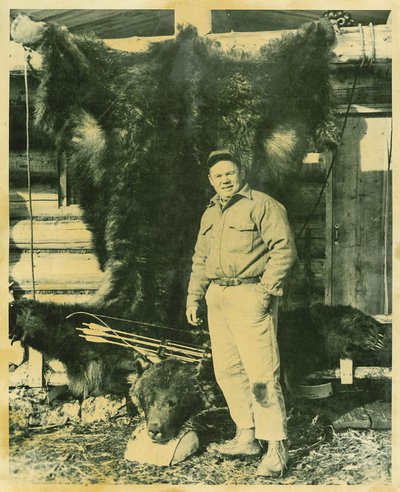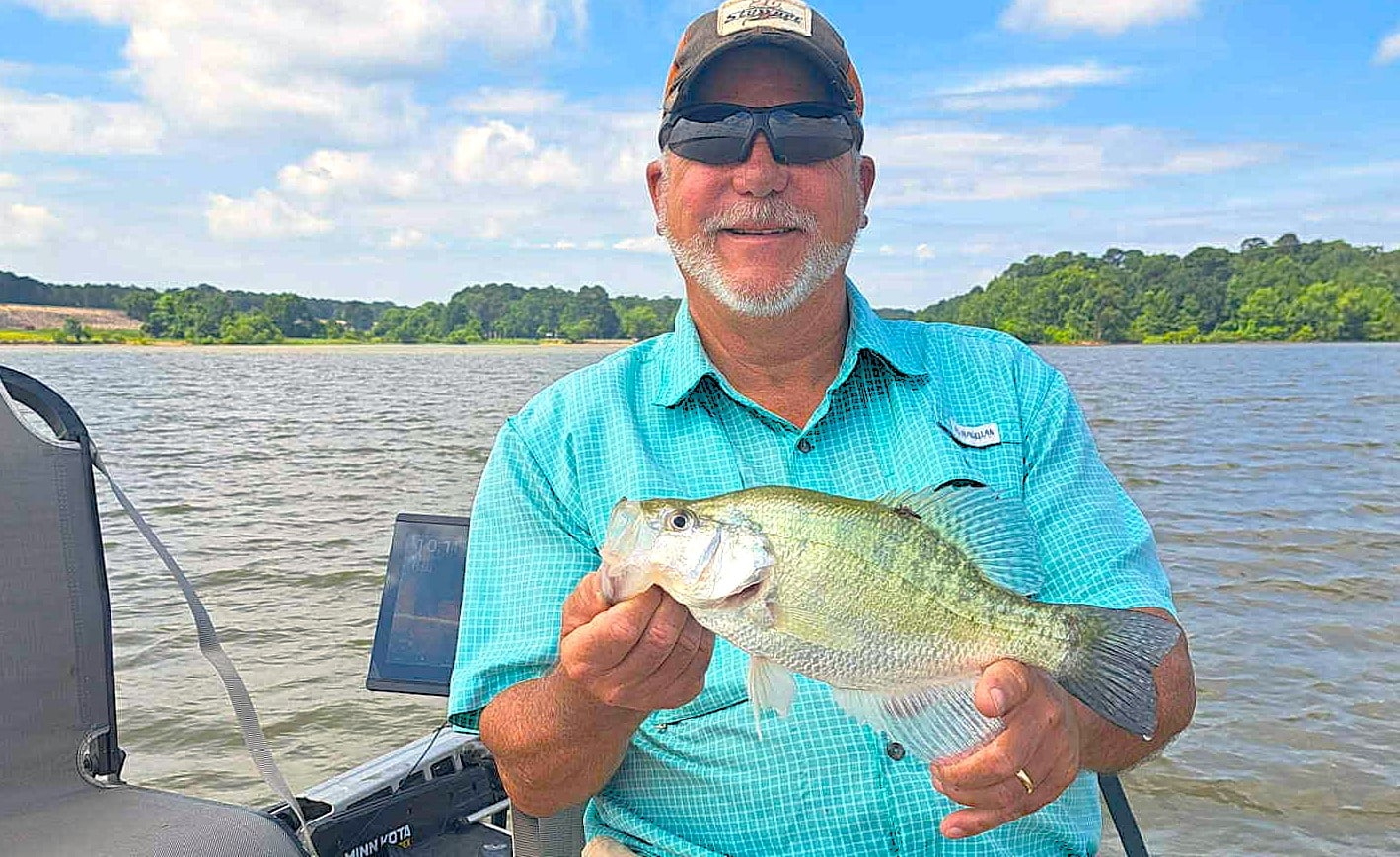Hancock’s pluck featured in Arkansas Wildlife magazine
ON 08-24-2022

Aug. 24, 2022
Jeff Williams
Editor, Arkansas Wildlife Magazine

This year marks two conservation milestones in Arkansas. The Buffalo River became the country’s first national river and the Cache River was saved from channelization about 50 years ago.
Although the bodies of water share few characteristics, their conservation histories are similar. One would have been drowned by two dams in the Ozarks and the other would have been reconfigured in the Mississippi Delta had two people not stepped up to shut down the heavy machinery.
The September/October issue of Arkansas Wildlife features the story of Dr. Rex Hancock, a Stuttgart dentist who built a coalition that stopped the straightening of the Cache River 50 years ago, in many ways similar to Dr. Neil Compton’s approach to keeping the Buffalo flowing freely. The issue also includes an update on Arkansas black bears, a profile of the new Keep Arkansas Beautiful Commission director and the state of affairs of the eastern wild turkey in Arkansas, as well as many other topics.
A one-year, bimonthly subscription to Arkansas Wildlife costs $12 and includes five issues plus the 13-month calendar issue, which is published July 1 and includes hunting seasons, sunrise/sunset times and important dates in the outdoors. Enjoy a sample of the Rex Hancock story featured in the current issue, then subscribe at arkansaswildlife.com or by calling 800-283-2664.

‘The Heart of an Animal’
Hancock’s Passion Put End to Cache Channelization
About the time legislation was signed to designate the Buffalo National River in the Ozarks, the demolition of the Cache River was beginning in the Mississippi Delta.
Dr. Neil Compton, who formed the Ozark Society in Fayetteville in 1962, and friends were celebrating their conservation success after the first national river was established March 1, 1972. Meanwhile, Dr. Rex Hancock and cohorts were struggling to keep the Army Corps of Engineers from altering a very different river.
Like the Buffalo, the Cache is among Arkansas’s greatest natural assets. A wide variety of birds, mammals, reptiles and fish thrive in its oak bottomlands, and tupelo and cypress wetlands. It’s a haven for wintering waterfowl along the Mississippi Flyway, which is why hunters are drawn to it.
Not only is the Cache good for wildlife, its wetlands and oxbows are reservoirs that catch and hold rainwater, a process that reduces flooding and sedimentation. The Ramsar Convention named The Big Woods of the Cache and lower White River Wetlands of International Importance in 1989.
Flood Control
The potential conservation nightmares these rivers faced began with a series of congressional acts to control flooding across the country – amendments and various versions were passed in 1917, 1928, 1936-39, 1941, 1944, 1946, 1950 and 1965. The last one put flood protection in the Corps of Engineers’ hands.
The Corps’ plan to “channelize” the Cache River, authorized as part of the Flood Control Act of 1950, would have turned the braided, meandering stream into a ditch or ditches, with a narrow buffer zone of bottomland timber at best. Including a section of Bayou DeView, about 230 miles of river would be forever remade. In 1970, $60 million were allotted to pay for the massive overhaul. The plan rolled through legislation, encouraged by some Arkansas lawmakers and many Arkansans who lived or owned land along the Cache.
But not by Hancock.
He was born in Laddonia, Missouri, July 6, 1923, and was a Navy pharmacist’s mate in the Seventh Fleet Amphibious Division during World War II. He received a DDS degree from the University of Missouri School of Dentistry before moving to Huntsville then relocating to Stuttgart in 1951 after experiencing its phenomenal duck hunting.

Humble Start
A maze of irrigation ditches and rivulets in northeastern Arkansas and southeastern Missouri gives birth to the Cache, which dumps into the White River at Clarendon. Farmers and local residents long had a love/hate relationship with the Cache. Although it provided a transportation route, food, water, timber, hides, fish and other necessities for various inhabitants for hundreds of years, its floods periodically brought disaster.
By the mid-20th century, many local landowners and politicians were convinced that dredging and ditching the upper portion of the river would end the misery of flooding. Some of them figured The Big Woods, which once covered millions of acres, were past the point of saving.
The Arkansas Game and Fish Commission and other public and private conservation agencies didn’t hold the same view. In 1971, the AGFC acquired 3,888 acres for Black Swamp Wildlife Management Area in Woodruff County. The area has grown to about 6,400 acres of bottomland hardwoods and wetlands surrounding the Cache River.
The AGFC openly opposed channelization. The first legal effort to block the Corps’ plan – led by Hancock and backed by the Arkansas Wildlife Federation, Arkansas Duck Hunters Association, Arkansas Ecology Center and others – was bulldozed by Judge J. Smith Henley in Little Rock, who ruled in favor of the Corps project May 5, 1972. An appeal immediately was filed with the 8th U.S. Circuit Court of Appeals in St. Louis. The AGFC joined the lawsuit, which was handled by Richard Arnold, who later became chief justice of that very court.
In July 1972, the Corps riled everyone associated with the issue by dredging about 8 miles of river while the case remained under appeal. The court found Dec. 15, 1972, that the Corps’ environmental impact statement didn’t pass muster. Work in the river was ordered stopped in March 1973 and, although the impact statement was approved three years later, Congress pulled the plug on channelization.
Airing Differences
The conservation story of the Cache River has been told many times, although it’s probably safe to say that even people who were tuned into the issue didn’t follow the Subcommittee on Water Resources of Committee on Public Works public hearings, which were not about whether the project would be defunded; they were about whether the Corps’ plan to mitigate habitat for fish and wildlife was adequate.
Hancock spoke against the project and mitigation; Arkansas Rep. Bill Alexander and a contingent of representatives from his district, including the Cache River Basin Committee, spoke in favor of the mitigation plan.
Rep. Ray Roberts of Texas – a Navy veteran with a background in agricultural business – led the subcommittee’s proceedings….
Visit https://www.agfc.com/en/resources/arkansas-wildlife/magazine/ and click on the link to ‘The Heart of an Animal’ to learn the rest of the story and how one man’s passion drove the conservation effort to save the river and wetlands responsible for Arkansas’s rich duck-hunting heritage.
Recent News
Subscribe to Our Weekly Newsletter E-mails
Don’t miss another issue. Sign up now to receive the AGFC Wildlife Weekly Newsletter in your mailbox every Wednesday afternoon (Waterfowl Reports are published weekly during waterfowl season and periodically outside the season). Fishing Reports arrive on Thursdays. Fill in the following fields and hit submit. Thanks, and welcome!


